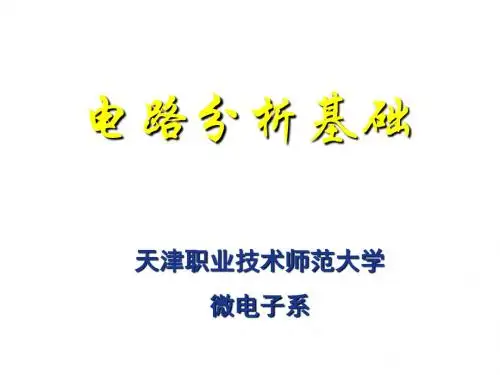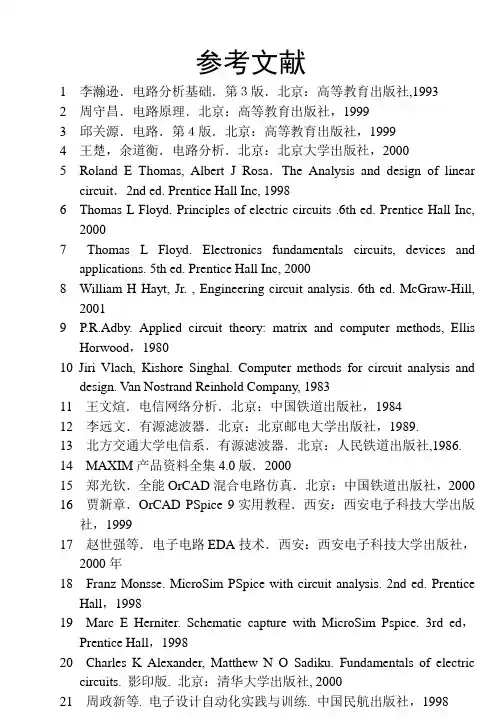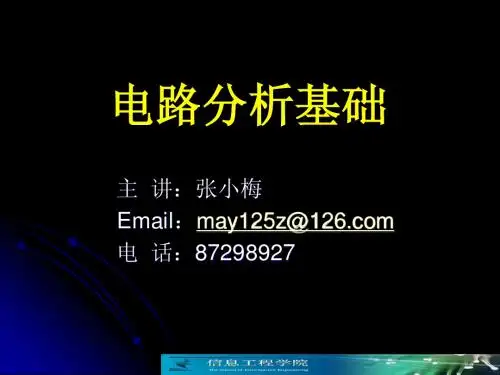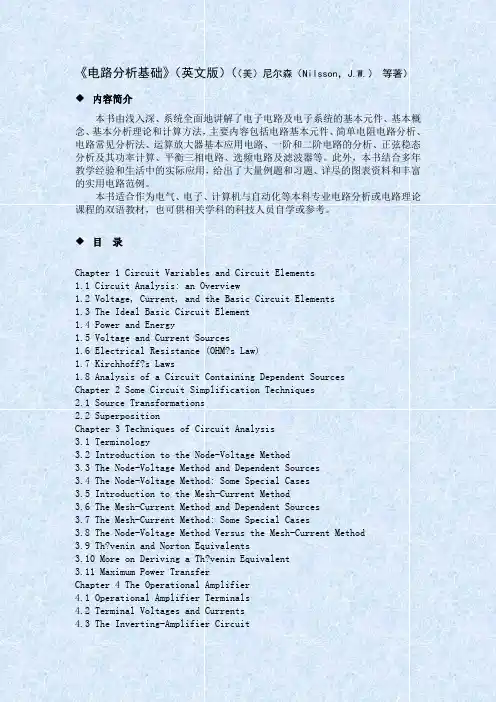《电路分析基础》封面及参考文献
- 格式:ppt
- 大小:946.50 KB
- 文档页数:4




参考文献1 李瀚逊.电路分析基础.第3版.北京:高等教育出版社,19932周守昌.电路原理.北京:高等教育出版社,19993邱关源.电路.第4版.北京:高等教育出版社,19994王楚,余道衡.电路分析.北京:北京大学出版社,20005 Roland E Thomas, Albert J Rosa.The Analysis and design of linearcircuit.2nd ed. Prentice Hall Inc, 19986 Thomas L Floyd. Principles of electric circuits .6th ed. Prentice Hall Inc,20007 Thomas L Floyd. Electronics fundamentals circuits, devices andapplications. 5th ed. Prentice Hall Inc, 20008 William H Hayt, Jr. , Engineering circuit analysis. 6th ed. McGraw-Hill,20019 P.R.Adby. Applied circuit theory: matrix and computer methods, EllisHorwood,198010 Jiri Vlach, Kishore Singhal. Computer methods for circuit analysis anddesign. Van Nostrand Reinhold Company, 198311王文煊.电信网络分析.北京:中国铁道出版社,198412李远文.有源滤波器.北京:北京邮电大学出版社,1989.13北方交通大学电信系.有源滤波器.北京:人民铁道出版社,1986.14 MAXIM产品资料全集4.0版.200015郑光钦.全能OrCAD混合电路仿真.北京:中国铁道出版社,2000 16贾新章.OrCAD PSpice 9实用教程.西安:西安电子科技大学出版社,199917 赵世强等.电子电路EDA技术.西安:西安电子科技大学出版社,2000年18Franz Monsse. MicroSim PSpice with circuit analysis. 2nd ed. Prentice Hall,199819 Marc E Herniter. Schematic capture with MicroSim Pspice. 3rd ed,Prentice Hall,199820 Charles K Alexander, Matthew N O Sadiku. Fundamentals of electriccircuits. 影印版. 北京:清华大学出版社, 200021 周政新等. 电子设计自动化实践与训练. 中国民航出版社,1998。


![参考文献_电路分析基础_[共3页]](https://uimg.taocdn.com/3754202904a1b0717ed5dd95.webp)
参考文献[1] 刘志民.电路分析(修订版):面向21世纪高等职业技术教育电子电工类规划教材.西安:西安电子科技大学出版社,2007.[2] 祁鸿芳.电路分析基础:21世纪高职高专规划教材·机电系列.北京:北京交通大学出版社,2006.[3] 刘克旺,马琳,宋剑英.电路基础:21世纪高等职业教育规划教材.北京:国防工业出版社,2006.[4] (美)Thomas L.Floyd 著,夏琳,施惠琼译.电路基础(第6版),北京:清华大学出版社,2006.[5] 杨承毅.电子技能实训基础—电子元器件的识别和检测(第2版),北京:人民邮电出版社,2007.[6] 王兆义.电工考级指南—电工电子类职业技能培训丛书,北京:高等教育出版社,2006.[7] 张小林.职业技能鉴定指南—电子设备装接工分册,北京:科学技术文献出版社,2002.[8] 张翠霞,盛鸿宇.电子工艺实训教材—高职高专院校实训教材系列,北京:科学出版社,2004.[9] 李光兰.电子工艺与设备—教育部高职高专自动化技术类专业教指委推荐教材,天津:天津大学出版社,2008.[10] 林占江,林放.电子测量仪器原理与使用,北京:电子工业出版社,2006.[11] 王昊,李昕,郑凤翼.通用电子元器件的选用与检测,北京:电子工业出版社,2006.[12] 王春江.电线电缆手册(第1册,第2版),《电线电缆手册》编委会组编,北京:机械工业出版社,2002.[13] 周惠潮.常用电子元件及典型应用,北京:电子工业出版社,2005.[14] 梁瑞林.贴片式电子元件,北京:科学出版社,2008.[15] 刘建清.从零开始学电子元器件识别与检测技术,北京:国防工业出版社,2007.[16] 许胜辉.电子技能实训,北京:人民邮电出版社,2005.[17] 王成安.电子技术基本技能综合训练,北京:人民邮电出版社,2005.[18] 李三波.电子工艺和电子技能实训,北京:北京航空航天大学出版,2008.[19] 苏丽萍.电子技术基础(第二版),西安:西安电子科技大学出版社,2006.[20] 黄大刚等.电路基础实验,北京:清华大学出版社,2008.[21] 梁宗裕等.小家电电路精选,北京:金盾出版社,2000.[22] 何希才.常用电子电路应用365例,北京:电子工业出版社,2006.[23] 高林,鲍洁.高等职业教育专业课程体系改革与创新—职业竞争力导向的“工作过程—支撑平台系统化课程”模式与典型方案,北京:人民邮电出版社,2009.219。

![参 考 文 献_电路基础(第4版)_[共2页]](https://uimg.taocdn.com/246660a18e9951e79b8927e9.webp)
参考文献
[1]邱关源.电路.第四版.北京:高等教育出版社,1999.
[2]江泽佳.电路原理(上、下册).第三版.北京:高等教育出版社,1992.
[3]李瀚荪.电路分析基础(上、中、下册).第三版.北京:高等教育出版社,1993.[4]周守昌.电路原理(上、下册).北京:高等教育出版社,1999.
[5]江缉光.电路原理(上、下册).北京:清华大学出版社,1996.
[6]周长源.电路理论基础.第二版.北京:高等教育出版社,1996.
[7]胡翔骏.电路基础.北京:高等教育出版社,1996.
[8]李瀚荪.电路与磁路.北京:中央广播电视大学出版社,1994.
[9]蔡元宇.电路与磁路(上、下册).北京:高等教育出版社,1991.
[10]张洪让.电工基础.北京:高等教育出版社,1990.
[11]俞大光.电路及磁路(上、下册).北京:高等教育出版社,1987.
[12]沙玉钧.线性电路分析.北京:高等教育出版社,1987.
[13]王俊鹍.电路例题精选.郑州:河南科学技术出版社,1993.
[14]杨育霞.电路实验——操作与仿真.郑州:郑州大学出版社,2003.。

《电路分析基础》(英文版)((美)尼尔森(Nilsson,J.W.)等著)◆内容简介本书由浅入深、系统全面地讲解了电子电路及电子系统的基本元件、基本概念、基本分析理论和计算方法,主要内容包括电路基本元件、简单电阻电路分析、电路常见分析法、运算放大器基本应用电路、一阶和二阶电路的分析、正弦稳态分析及其功率计算、平衡三相电路、选频电路及滤波器等。
此外,本书结合多年教学经验和生活中的实际应用,给出了大量例题和习题、详尽的图表资料和丰富的实用电路范例。
本书适合作为电气、电子、计算机与自动化等本科专业电路分析或电路理论课程的双语教材,也可供相关学科的科技人员自学或参考。
◆目录Chapter 1 Circuit Variables and Circuit Elements1.1 Circuit Analysis: an Overview1.2 Voltage, Current, and the Basic Circuit Elements1.3 The Ideal Basic Circuit Element1.4 Power and Energy1.5 Voltage and Current Sources1.6 Electrical Resistance (OHM?s Law)1.7 Kirchhoff?s Laws1.8 Analysis of a Circuit Containing Dependent SourcesChapter 2 Some Circuit Simplification Techniques2.1 Source Transformations2.2 SuperpositionChapter 3 Techniques of Circuit Analysis3.1 Terminology3.2 Introduction to the Node-Voltage Method3.3 The Node-Voltage Method and Dependent Sources3.4 The Node-Voltage Method: Some Special Cases3.5 Introduction to the Mesh-Current Method3.6 The Mesh-Current Method and Dependent Sources3.7 The Mesh-Current Method: Some Special Cases3.8 The Node-Voltage Method Versus the Mesh-Current Method3.9 Th?venin and Norton Equivalents3.10 More on Deriving a Th?venin Equivalent3.11 Maximum Power TransferChapter 4 The Operational Amplifier4.1 Operational Amplifier Terminals4.2 Terminal Voltages and Currents4.3 The Inverting-Amplifier Circuit4.4 The Summing-Amplifier Circuit4.5 The Noninverting-Amplifier Circuit4.6 The Difference-Amplifier Circuit4.7 The ComparatorChapter 5 The Natural and Step Response of RL and RC Circuits5.1 The Inductor5.2 The Capacitor5.3 Series-Parallel Combinations of Inductance and Capacitance5.4 Natural Response of RL and RC Circuits5.5 Step Response of RL and RC Circuits5.6 The Integrating AmplifierChapter 6 Natural and Step Responses of RLC Circuits6.1 Introduction to the Natural Response of a Parallel RLC Circuit 6.2 The Forms of the Natural Response of a Parallel RLC Circuit 6.3 The Step Response of a Parallel RLC Circuit6.4 The Natural and Step Response of a Series RLC CircuitChapter 7 Sinusoidal Steady-State Analysis7.1 The Sinusoidal Source7.2 The Sinusoidal Response7.3 The Phasor7.4 The Passive Circuit Elements in the Frequency Domain7.5 Kirchhoff?s Laws in the Frequency Domain7.6 Circuit Simplifications7.7 The Node-Voltage Method7.8 The Mesh-Current Method7.9 Instantaneous, Average, and Reactive Power7.10 The rms Value and Power Calculations7.11 Complex Power and Power CalculationsChapter 8 Balanced Three-Phase Circuits8.1 Balanced Three-Phase Voltages8.2 Three-Phase Voltage Sources8.3 Analysis of the Wye-Wye Circuit8.4 Analysis of the Wye-Delta Circuit8.5 Power Calculations in Balanced Three-Phase Circuits8.6 Measuring Average Power in Three-Phase CircuitsChapter 9 Introduction to Frequency Selective Circuits9.1 Some Preliminaries9.2 Low-Pass Filters9.3 High-Pass Filters9.4 Bandpass Filters9.5 Bandreject Filters。
